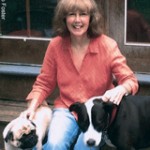One day a friend foisted a stray dog on Susan Meddaugh. Usually a soft touch when it comes to animals, Meddaugh had her misgivings. She named the dog Martha after her friend. If the dog was horrible, the name would be her revenge, but if the dog was wonderful, the friend would be forever honored. Martha not only turned out to be a fabulous dog, she was the inspiration for Meddaugh’s most famous children’s books.
Technically, Meddaugh’s son came up with the idea for Martha Speaks (Houghton Mifflin, 1992). He was eating a bowl of alphabet soup at the kitchen table, while Martha nosed around looking for her next meal. “If Martha ate alphabet soup, would she speak?” he asked.
“Ideas are gifts,” says Meddaugh. “But if you do what I do, you’re ready to grab them.” Although Meddaugh never intended to write and illustrate a series of Martha books, ideas and situations unique to Martha kept popping into her mind and she realized she wanted to find out what happened to her next. Currently, there are six Martha books. The most recent, Perfectly Martha (Houghton Mifflin) was released this year.
Meddaugh used the physical characteristics of their family dog to draw her character, but she gave the Martha character qualities she claims to lack. “I’d like to be more like Martha,” quips Meddaugh. “Feisty, stubborn, opinionated, outspoken, and strong.”
After Martha Speaks was released, Boston Magazine ran a feature on Faces to Watch. Martha, the character, was chosen as one of the celebrities. Not Meddaugh, but Martha! Meddaugh attended a fancy party and took her own dog as a stand-in for her popular character. Martha posed with Boston’s sexiest man and most powerful woman. “She was wonderful,” says Meddaugh.
Even in elementary school, Meddaugh knew she was an artist. She just didn’t know what kind. Her pictures always told stories. After college, she spent some time painting with oil on large canvasses, but found that she missed the structure that an assignment or a story provided. Working as a book designer and later as an art director for Houghton Mifflin taught her the finer points of creating mini-worlds in picture books.
Finally, she found the courage to go out on her own. Meddaugh’s favorite part of the creative process is coming up with the idea and solving problems. “The most fun is figuring out the magic as the story finds you,” she says. According to Meddaugh, picture books should be about the story. “The art should be illustrative, but not flashy or attention-seeking. . .In a 32-page picture book, I have to create a world where the character comes forward and is as real as a character in an adult novel.”
For Hog Eye (Houghton Mifflin, 1995) the world Meddaugh created was inspired by the first time she sent her shy five-year old off to school on the bus. But in her book, her characters are pigs instead of people. Meddaugh uses animals in her stories because they are more expressive to her, allowing her to loosen up and exaggerate.
The magic inherent to the traditional Cinderella story became Meddaugh’s as she createdCinderella’s Rat (Houghton Mifflin, 1997). It’s her favorite book because the story took over and seemed to come from somewhere outside her. While walking her dogs one day, she started thinking about her son’s pet rats, which led to Cinderella, which led to the rat that became a coachman. “What a peculiar experience to become a person,” she thought to herself. The story poured out of her, and she felt as if some muse looked over her shoulder and fed the lines to her. “That story was purely someone else,” she says. “The rats’ perhaps!”
In the past, Meddaugh has illustrated several books for other authors, but now prefers to write and illustrate her own work. She produces one book a year. “I’m just indulging myself,” she says. “I sit in this little room and entertain myself.” There’s always a moment of anxiety after she finishes a book when she worries no one will like it. Actually, it’s hard not to love a Susan Meddaugh book.


